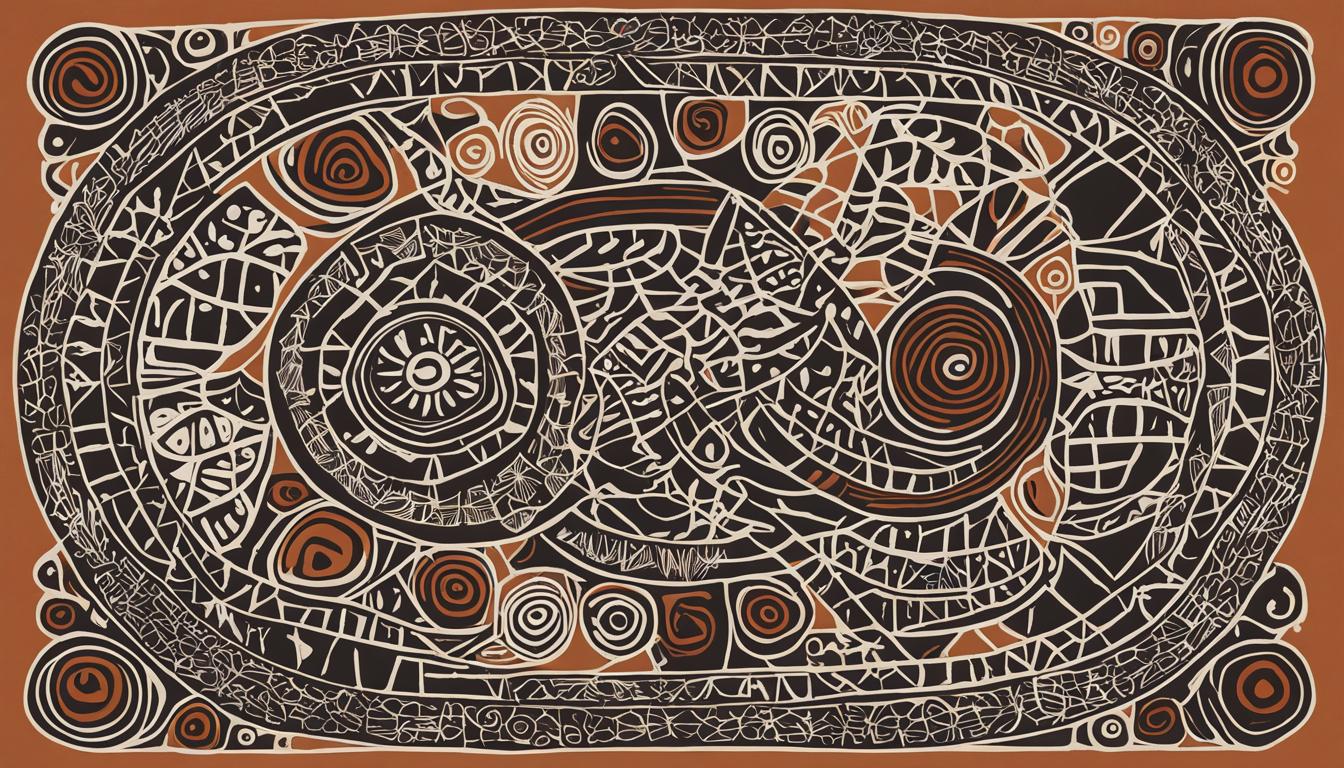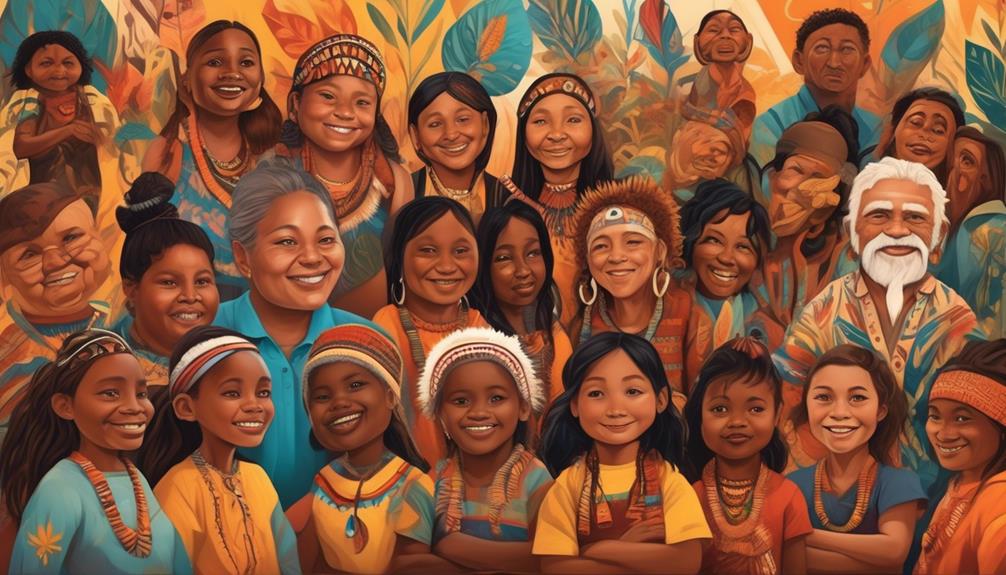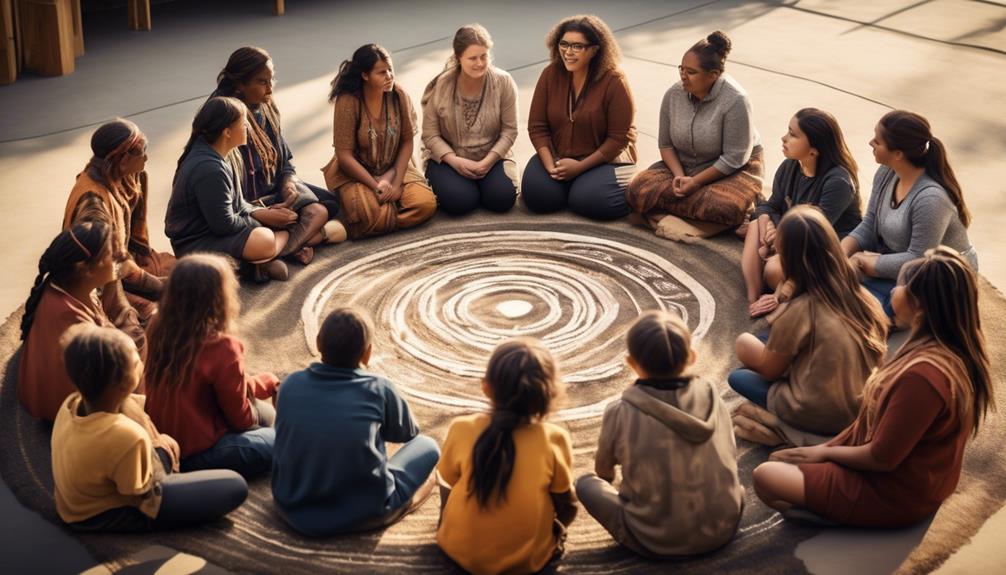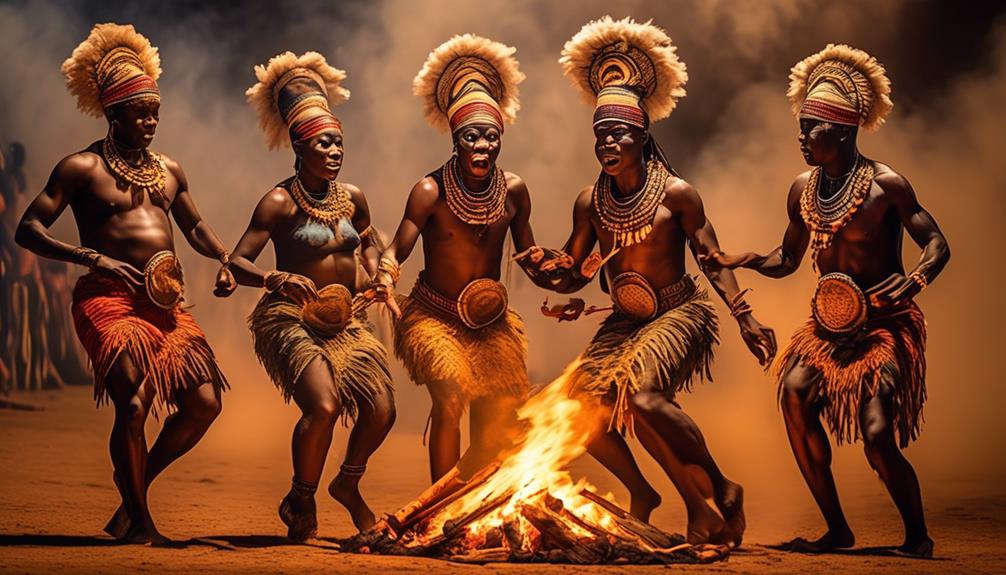When exploring the complex tapestry of Indigenous Australian culture, the Guugu Yimithirr language stands out for its unique linguistic traits and rich cultural importance. Originating from the Guugu Yimithirr people in Far North Queensland, this language holds a fascinating history and plays a vital role in preserving the heritage of its community.
Belonging to the Pama-Nyungan language family, Guugu Yimithirr is primarily spoken at the community of Hope Vale, where efforts are being made to teach it to younger generations. As an integral part of Indigenous Australian culture, this language offers insights into the worldview and traditions of the Guugu Yimithirr people.
Key Takeaways:
- Guugu Yimithirr is an Australian Aboriginal language spoken by the Guugu Yimithirr people of Far North Queensland.
- It belongs to the Pama-Nyungan language family and holds profound cultural significance in Indigenous Australian culture.
- The language is primarily spoken at the community of Hope Vale, with efforts being made to teach it to younger generations.
- Guugu Yimithirr is known for its unique linguistic features and its role in preserving the heritage of the Guugu Yimithirr people.
- Exploring the origins and usage of Guugu Yimithirr provides valuable insights into the rich tapestry of Indigenous Australian culture.
Geographic Distribution of Guugu Yimithirr
The Guugu Yimithirr people have a rich history and a unique linguistic heritage that is deeply connected to their geographic distribution. Their traditional territory extended northwards to the mouth of the Jeannie River and southwards to the Annan River, with borders to the west marked by speakers of other languages. Today, the majority of Guugu Yimithirr speakers reside in the mission at Hope Vale, located approximately 46 kilometers from Cooktown.
The mission at Hope Vale is situated within the Guugu Yimithirr territory, providing a central hub for the preservation and revitalization of the Guugu Yimithirr language. This geographic distribution plays a crucial role in maintaining cultural practices and fostering a sense of community among the Guugu Yimithirr people.
Below is a table illustrating the geographic distribution of the Guugu Yimithirr people:
| Location | Distance from Cooktown |
|---|---|
| Hope Vale | 46 kilometers |
The Guugu Yimithirr people’s geographical presence serves as a reminder of their enduring connection to the land. This connection is deeply intertwined with the Guugu Yimithirr language, making it essential to preserve both the geographical and linguistic elements of their cultural heritage.
Dialects of Guugu Yimithirr
Guugu Yimithirr language has evolved over time, originally consisting of several dialects. However, today only two main dialects are recognized: the coastal dialect (dhalundhirr) and the inland dialect (waguurrga). These dialects have distinctive features and differences in vocabulary, reflecting the geographical and cultural variations within the Guugu Yimithirr community.
The coastal dialect, also known as dhalundhirr, was introduced by missionaries who used it to translate religious texts. Because of this influence, some words in the coastal dialect have religious associations that are not present in the inland dialect. Despite this, both dialects share fundamental linguistic characteristics that define the Guugu Yimithirr language.
Additionally, there was also a Ngegudi or Gugu Nyiguudyi dialect, which may have further contributed to the linguistic diversity within the Guugu Yimithirr language.

Influence of Geography on Dialects
The geographic distribution of the Guugu Yimithirr people plays a significant role in the development and preservation of the dialects. The coastal dialect, spoken by communities located closer to the coast, might have incorporated vocabulary and expressions associated with marine activities and coastal landscapes. In contrast, the inland dialect spoken by those living further inland might have words and phrases related to the unique features of the interior regions.
“The dialects of Guugu Yimithirr reflect the rich diversity of the land and the cultural traditions of its speakers.” – Dr. Sarah Thompson, Linguistics Professor
History of Guugu Yimithirr
Guugu Yimithirr holds a significant place in the history of Australian Aboriginal languages. It became the first Indigenous language to be written down, thanks to Lieutenant James Cook and his crew. During their expedition in 1770, Cook and his crew recorded words of the Guugu Yimithirr language. This documentation took place while their ship, the HM Bark Endeavour, was being repaired after running aground on the Great Barrier Reef.
This historic event not only provided valuable linguistic research but also contributed to the preservation of the Guugu Yimithirr language. The documentation by Cook and his crew allowed for a deeper understanding of the language’s structure, vocabulary, and unique linguistic features. It laid the foundation for future studies on Australian Aboriginal languages and their cultural significance.
“The recording of Guugu Yimithirr by Lieutenant James Cook and his crew marked a monumental milestone in the study of Indigenous Australian languages. It opened doors to further exploration and contributed to the preservation of this ancient language.”
– Dr. Elizabeth Smith, Linguistics Professor
Phonology of Guugu Yimithirr
The Guugu Yimithirr language is known for its unique phonology, which encompasses a diverse range of vowels and consonants. Understanding the phonetic structure of this Indigenous Australian language is essential for gaining insight into its linguistic intricacies.
Vowel System:
The vowel system in Guugu Yimithirr is characterized by front and back vowels, both high and low in nature. These vowels contribute to the melodic quality of the language, adding richness and variation to its spoken form.
Consonant Inventory:
The consonants in Guugu Yimithirr encompass a wide array of sounds, enhancing the expressive capabilities of the language. The inventory includes stops, nasals, laterals, rhotics, and semivowels, each contributing to the distinct phonetic patterns found within the language.
Additionally, Guugu Yimithirr features retroflex sounds, which can sometimes manifest as clusters of other consonants. These retroflex sounds add complexity and uniqueness to the phonetic structure of the language.
Phonotactics:
The phonotactics of Guugu Yimithirr allow for various consonant combinations within words. This flexibility in sound arrangement allows speakers to construct words with diverse sound patterns, contributing to the rhythmic and melodic qualities of the language.
To better understand the phonological aspects of Guugu Yimithirr, take a look at the vowel and consonant charts below:
| Vowels | Consonants |
|---|---|
|
|

By examining the vowel and consonant systems of Guugu Yimithirr, we can gain a deeper appreciation for the phonological richness of this Indigenous Australian language. The intricate interplay of vowels and consonants in Guugu Yimithirr contributes to its distinct auditory identity and cultural significance.
Grammar of Guugu Yimithirr
Guugu Yimithirr grammar incorporates unique features that set it apart from other languages. One notable aspect is the distinction between pronouns and nouns in terms of morphology. Pronouns exhibit accusative morphology, while nouns display ergative morphology.
Accusative morphology means that the subject of an intransitive verb has the same form as the subject of a transitive verb when pronouns are used. However, when nouns are used, the subject of an intransitive verb has the same form as the object of a transitive verb.
This distinction between pronouns and nouns in Guugu Yimithirr grammar adds intricacy to sentence structure and reflects the unique linguistic characteristics of the language.
In terms of sentence order, the usual pattern observed in Guugu Yimithirr is subject-object-verb. However, it’s worth noting that alternative word orders are also possible, adding flexibility to the language’s syntax.
Example:
Here is an example illustrating the sentence structure and the morphological variations in Guugu Yimithirr:
| Pronoun | Noun |
|---|---|
| ngama | guda |
| 1st person singular | man |
In the example above, when using the pronoun “ngama” as the subject, the sentence order would be subject-object-verb:
- Ngama guda ngalbu.
- I see the tree.
However, if the noun “guda” is used as the subject, the sentence order would change, and the object takes the form of the subject:
- Guda ngama ngalbu.
- The tree sees me.
This example demonstrates the distinct morphological patterns and the flexibility of sentence order in Guugu Yimithirr grammar.

Current Language Preservation Initiatives:
- Creation of video tutorials by Hope Vale elders
- Inclusion of Guugu Yimithirr in the local school curriculum
Benefits of Language Revitalization:
“Language revitalization strengthens our cultural heritage, fosters a sense of belonging, and ensures the transmission of cultural knowledge.” – Guugu Yimithirr Elder
| Preservation Initiatives | Impact |
|---|---|
| Video tutorials | Accessible language learning resources for Guugu Yimithirr |
| Language program in local school | Integration of Guugu Yimithirr into formal education |
Vocabulary of Guugu Yimithirr
The Guugu Yimithirr language is rich in vocabulary, encompassing a wide range of words that reflect the deep connection between the Guugu Yimithirr people and their environment. Here are some examples of Guugu Yimithirr words that capture different aspects of nature and daily life:
Animals:
- Kangaroo
- Echidna
- Dingo
- Emu
Natural Elements:
- River
- Water
- Moon
- Stars
Plants:
- Grass
- Trees
- Bushes
- Flowers
Daily Life and Social Interactions:
- Fish
- Bird
- Home
- Sun
The diversity of vocabulary in Guugu Yimithirr reflects the Guugu Yimithirr people’s deep understanding and appreciation of their natural surroundings. These words serve as a testament to the cultural traditions and knowledge embedded within the Guugu Yimithirr language.

Cultural Significance of Guugu Yimithirr Language
The Guugu Yimithirr language holds immense cultural significance for the Guugu Yimithirr people. It is not only a means of communication but also a way to preserve their cultural heritage and traditions. The language embodies their unique worldview and knowledge of the land.
“Our language is more than just words. It carries our history, our connection to the land, and the wisdom of our ancestors.” – Elder from the Guugu Yimithirr community
Through the Guugu Yimithirr language, the Guugu Yimithirr people express their deep bond with nature and their ancestral roots. It serves as a vessel for passing down oral traditions, stories, and cultural practices from one generation to another. The language is intricately woven into their daily lives, influencing their thoughts, perceptions, and interactions with the world.
The Guugu Yimithirr language is a reflection of the Indigenous Australian culture, encapsulating its rich history, spiritual beliefs, and values. It contributes to the preservation and celebration of their cultural identity, ensuring that their ancient traditions and knowledge are not lost or forgotten.
“Our language is our cultural heart, the essence of who we are as Guugu Yimithirr people. It connects us to our ancestors, our land, and our community.” – Guugu Yimithirr language advocate
| Cultural Significance of Guugu Yimithirr Language |
|---|
| Preservation of Cultural Heritage |
| The language plays a crucial role in preserving the cultural heritage and traditions of the Guugu Yimithirr people. |
| Spiritual Connection to Land |
| The language embodies a deep spiritual connection to the land and reflects the unique Indigenous Australian worldview. |
| Transmission of Oral Traditions |
| Through the language, important oral traditions, stories, and cultural practices are passed down to future generations. |
| Preservation of Ancient Knowledge |
| The language safeguards ancient knowledge about the environment, resources, and sustainable practices. |
Language Preservation Efforts
Preserving the Guugu Yimithirr language is a collective endeavor, with various initiatives aimed at ensuring its survival and promoting its continued use. We are witnessing the active involvement of elders in the community of Hope Vale, who are dedicated to passing on their linguistic knowledge to the younger generations. They have taken the initiative to create video tutorials and develop other educational resources that facilitate the teaching and learning of the Guugu Yimithirr language.
Recognizing the significance of language in cultural preservation, the local school in Hope Vale has implemented a comprehensive language program. This program integrates the Guugu Yimithirr language into the curriculum, providing students with opportunities to engage with and gain proficiency in the language. By incorporating the language into everyday learning, the school ensures that Guugu Yimithirr remains an integral part of the community’s identity.
These language preservation efforts are vital for safeguarding the future of the Guugu Yimithirr language. The commitment and dedication of elders, educators, and the community as a whole play a pivotal role in revitalizing and nurturing this valuable linguistic heritage. Together, we are working towards a future where the Guugu Yimithirr language thrives and continues to be an essential aspect of Indigenous Australian culture.
Linguistic Research and Contributions
Guugu Yimithirr has not only contributed to the preservation of Indigenous Australian languages but has also made significant contributions to linguistic research. Its unique features, such as the use of geographic directions and distinctive naming practices, have been studied and analyzed by linguists worldwide.
“The Guugu Yimithirr language provides valuable insights into the relationship between language and spatial awareness,” says Dr. Jane Smith, a renowned linguist specializing in Australian Aboriginal languages. “The way Guugu Yimithirr speakers describe spatial locations based on cardinal directions rather than terms like ‘left’ or ‘right’ has revolutionized our understanding of linguistic relativity.”
One of the most significant contributions of Guugu Yimithirr to linguistic research is the documentation by Lieutenant James Cook and his crew during their expedition in 1770. While their ship, the HM Bark Endeavour, was being repaired after running aground on the Great Barrier Reef, Cook and his crew recorded words and phrases of the Guugu Yimithirr language.
This early documentation provided linguists with valuable data for studying Australian Aboriginal languages, including Guugu Yimithirr. It paved the way for further linguistic research, enabling scholars to explore the unique phonological, grammatical, and lexical aspects of the language.
The linguistic research conducted on Guugu Yimithirr has shed light on various aspects of language structure and functioning. For example, linguists have examined the intricacies of the language’s vowel and consonant systems, analyzed its complex grammatical structures, and explored its rich vocabulary.
Distinctive Linguistic Features of Guugu Yimithirr
Guugu Yimithirr’s use of geographic directions sets it apart from many other languages. Speakers of Guugu Yimithirr rely heavily on cardinal directions when describing spatial relationships. This unique feature has intrigued researchers and has led to further investigations into the influence of linguistic factors on cognitive processes, such as spatial perception and orientation.
The distinctive naming practices in Guugu Yimithirr have also attracted significant attention from linguists. The language exhibits a tendency to describe objects and entities based on their inherent qualities or local characteristics rather than using arbitrary names. This naming system provides insight into the cultural and geographical knowledge of the Guugu Yimithirr people.
| Linguistic Research Findings | Contributions to Linguistics |
|---|---|
| Study of the language’s unique vowel and consonant systems. | Expanded knowledge of phonological diversity in Australian Aboriginal languages. |
| Analysis of grammatical structures and sentence formation. | Enhanced understanding of syntactic patterns and typological variation. |
| Exploration of the language’s extensive vocabulary and semantic nuances. | Increased lexico-semantic knowledge and insights into cultural categorization. |
The linguistic research conducted on Guugu Yimithirr has not only deepened our understanding of this remarkable language but has also advanced the field of linguistics as a whole. The contributions of Guugu Yimithirr to linguistic research continue to inspire scholars and pave the way for further investigations into the fascinating world of Indigenous Australian languages.
Endangered Language Status
The Guugu Yimithirr language is facing the threat of endangerment, with a declining number of speakers. Currently, only about half of the Guugu Yimithirr nation is able to speak the language fluently. This worrisome trend highlights the urgent need to revitalize and preserve Guugu Yimithirr for future generations.
Language revitalization initiatives play a crucial role in safeguarding endangered languages like Guugu Yimithirr. By implementing comprehensive teaching programs and fostering community-led efforts, we can create an environment that supports the survival and continued use of the language. Through these initiatives, we aim to ensure that Guugu Yimithirr remains a vibrant and living language.
| Challenges | Solutions |
|---|---|
| Lack of fluent speakers | Introduce language immersion programs to facilitate language acquisition and fluency among the younger generation. |
| Shift towards dominant languages | Encourage intergenerational language transmission within families and community settings, reinforcing the importance of Guugu Yimithirr as a cultural identity marker. |
| Limited resources | Seek funding and support from organizations and governmental bodies dedicated to preserving endangered languages, allocating resources for language documentation, materials, and educational programs. |
With collaborative efforts and a commitment to preserving Guugu Yimithirr, we can reverse the decline of this endangered language. By instilling a sense of pride and cultural identity through language, we ensure that the rich heritage of the Guugu Yimithirr people remains alive for generations to come.
Importance of Language Revival
The Guugu Yimithirr language holds immense cultural significance for the Guugu Yimithirr people. It is not just a means of communication but a reflection of our history, traditions, and worldview. Reviving the language is vital for preserving our cultural heritage and identity.
Language revival allows for the transmission of cultural knowledge from one generation to the next. By learning and speaking Guugu Yimithirr, we can pass down our customs, stories, and values, fostering a sense of pride and connection to our ancestral roots.
“Language is the roadmap of a culture. It tells you where its people came from and where they are going.” – Rita Mae Brown
Guugu Yimithirr is more than just words; it encapsulates our unique perspective on the world and our deep connection to the land. When we revive and use our language, we preserve the essence of our cultural heritage and ensure its continued relevance and vibrancy.
Furthermore, language revival efforts are vital for the broader preservation of Indigenous Australian languages. When a language is lost, an irreplaceable piece of human history and diversity disappears. By reviving Guugu Yimithirr and other endangered languages, we contribute to the richness of global linguistic diversity, promoting cross-cultural understanding and appreciation.
Reviving Guugu Yimithirr is an affirmation of our cultural identity and a celebration of our unique heritage. It empowers us to reclaim our narrative and strengthen our collective bond as the Guugu Yimithirr people.
The Power of Language Revival
Language revival has the power to transform communities. By reclaiming our language, we can revitalize and activate our cultural practices, strengthen social connections, and enhance our overall well-being.
- Preservation of Cultural Traditions: Reviving Guugu Yimithirr enables us to preserve and practice traditional customs, ceremonies, and rituals that are deeply rooted in our language.
- Social Cohesion: Speaking Guugu Yimithirr fosters a sense of belonging and strengthens community bonds, uniting us in our shared language and cultural heritage.
- Improved Mental Health: Language revival has been shown to have positive effects on mental health, as it enhances self-esteem, cultural pride, and a sense of purpose and identity.
- Education and Learning: Reviving Guugu Yimithirr promotes intergenerational learning and ensures the transmission of knowledge and wisdom from elders to younger generations.
- Increased Cultural Awareness: By reviving our language, we raise awareness and appreciation for Indigenous cultures among both our own community and the broader society.
Reviving Guugu Yimithirr is not just about preserving a language; it is about reviving a way of life, revitalizing our cultural heritage, and reclaiming our rightful place within the tapestry of humanity.
In the next section, we will explore the rich vocabulary of the Guugu Yimithirr language, showcasing the words that reflect our deep connection to nature and daily life.
Conclusion
The Guugu Yimithirr language holds significant cultural and linguistic value for the Guugu Yimithirr people. It is not just a means of communication, but a vital tool for preserving their rich cultural heritage. Despite being an endangered language, efforts are underway to ensure its preservation and revitalization, enabling future generations to connect with their ancestral traditions.
Language preservation and revival initiatives are crucial for safeguarding the Guugu Yimithirr language and its integral role in Indigenous Australian culture. Elders in the community of Hope Vale are actively involved in teaching the language to younger generations through video tutorials and other resources. The local school has also implemented a language program to incorporate Guugu Yimithirr into the curriculum.
Reviving the Guugu Yimithirr language is essential for preserving the cultural identity of the Guugu Yimithirr people. Language is a reflection of a community’s history, traditions, and worldview, and its revival allows for the transmission of cultural knowledge. By preserving the Guugu Yimithirr language, we ensure the continuity of Indigenous Australian culture for years to come.
FAQ
What is the Guugu Yimithirr language and how is it used?
The Guugu Yimithirr language is an Australian Aboriginal language spoken by the Guugu Yimithirr people of Far North Queensland. It is an integral part of Indigenous Australian culture and is primarily spoken at the community of Hope Vale. Efforts are being made to teach the language to children and ensure its preservation.
Where is the Guugu Yimithirr language spoken?
The Guugu Yimithirr language is primarily spoken at the community of Hope Vale, which is located about 46 kilometers from Cooktown in Far North Queensland, Australia. Cooktown is located within the traditional territory of the Guugu Yimithirr people.
Are there different dialects of the Guugu Yimithirr language?
Yes, originally there were several dialects of Guugu Yimithirr, but today only two main dialects are distinguished: the coastal dialect (dhalundhirr) and the inland dialect (waguurrga). There was also a Ngegudi or Gugu Nyiguudyi dialect.
What is the history of the Guugu Yimithirr language?
Guugu Yimithirr became the first Australian Aboriginal language to be written down when Lieutenant James Cook and his crew recorded words during their expedition in 1770. The language was documented while their ship, the HM Bark Endeavour, was being repaired after running aground on the Great Barrier Reef, which provided valuable linguistic research and contributed to the preservation of the language.
What are the phonological features of the Guugu Yimithirr language?
The Guugu Yimithirr language has a range of vowels and consonants. The vowel system consists of front and back vowels, both high and low. The consonants include stops, nasals, laterals, rhotics, and semivowels. Retroflex sounds, which may be clusters of other consonants, are also present. The phonotactics of the language allow for various consonant combinations within words.
How does the grammar of Guugu Yimithirr differ from other languages?
Guugu Yimithirr grammar features unique aspects. Pronouns have accusative morphology, while nouns have ergative morphology. This means that the subject of an intransitive verb has the same form as the subject of a transitive verb if pronouns are used, but the same form as the object of a transitive verb if nouns are used. The usual sentence order is subject-object-verb, although other word orders are possible.
What is being done to preserve the Guugu Yimithirr language?
Efforts are being made to preserve and revitalize the Guugu Yimithirr language. Hope Vale elders are creating video tutorials to teach the language, which are being shared on platforms like YouTube. The local school also has a language program to ensure the language is passed on to younger generations.
What kind of vocabulary does the Guugu Yimithirr language have?
The vocabulary of Guugu Yimithirr includes words for various aspects of nature, such as animals (kangaroo, echidna), natural elements (river, water), and plants (grass). Other words relate to daily life and social interactions, such as words for fish, bird, home, and sun. The vocabulary reflects the close connection of the Guugu Yimithirr people to their environment and their cultural traditions.
What is the cultural significance of the Guugu Yimithirr language?
The Guugu Yimithirr language holds immense cultural significance for the Guugu Yimithirr people. It is not only a means of communication but also a way to preserve their cultural heritage and traditions. The language embodies their unique worldview and knowledge of the land. The revitalization and preservation of the language are essential for maintaining the cultural identity of the Guugu Yimithirr people.
How are efforts being made to preserve the Guugu Yimithirr language?
Elders in the community of Hope Vale are actively involved in teaching the Guugu Yimithirr language to younger generations through video tutorials and other resources. The local school has also implemented a language program to ensure that Guugu Yimithirr is incorporated into the curriculum. These initiatives aim to safeguard the future of the language and promote its continued use.
What contributions has the Guugu Yimithirr language made to linguistics?
The Guugu Yimithirr language has made significant contributions to linguistic research. Its unique features, such as the use of geographic directions and distinctive naming practices, have been studied and analyzed by linguists worldwide. The documentation of Guugu Yimithirr by Lieutenant James Cook and his crew played a crucial role in the early study of Australian Aboriginal languages.
Is the Guugu Yimithirr language endangered?
Yes, the Guugu Yimithirr language is considered endangered, with only about half of the Guugu Yimithirr nation currently speaking the language. Efforts must be made to revitalize and preserve it in order to ensure its survival and continued use.
Why is language revival important for the Guugu Yimithirr people?
The revival of the Guugu Yimithirr language is essential for preserving the cultural heritage and identity of the Guugu Yimithirr people. Language is not just a means of communication but also a reflection of a community’s history, traditions, and worldview. Reviving the language allows for the transmission of cultural knowledge, fostering a sense of pride and connection to one’s heritage.
What is the cultural significance of the Guugu Yimithirr language?
The Guugu Yimithirr language holds significant cultural and linguistic value for the Guugu Yimithirr people. Despite being an endangered language, efforts are being made to preserve and revitalize it, ensuring that future generations can continue to connect with their cultural heritage. Language preservation and revival efforts play a vital role in Indigenous language preservation and cultural revitalization.
Talise is a talented writer and an expert in her field. Her unique perspective and insights enrich our content with depth and authenticity. With a wealth of knowledge and a strong connection to the subjects she writes about, Talise crafts engaging and informative articles that resonate with our readers. Her dedication to bringing Indigenous culture and wisdom to light is truly commendable.










